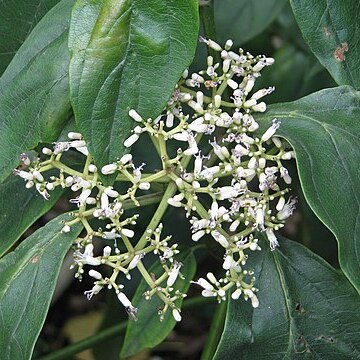Shrubs or small trees, evergreen, to 8(-15) m tall. Bark light brown. Branchlets of current year greenish, glabrous, or initially sparsely stellate-pubescent; branchlets of previous year gray-brownish, terete, glabrous, with sparse, small, rounded lenticels. Winter buds lanceolate-triangular, with a pair of separate scales; scales glabrous or stellate pubescent. Leaves always opposite, not clustered at apices of branchlets; stipules absent; petiole green, robust, 1-3.5(-5) cm, glabrous or stellate-pubescent; leaf blade green when young, elliptic to oblong or ovate-oblong, 8-16(-24) × 3-10 cm, leathery, abaxially usually glabrous, with dispersed reddish or yellow tiny glandular dots (sometimes compressed to appear like lepidote scales), adaxially glabrous, midvein raised abaxially, lateral veins 3-5(-8)-jugate, pinnate, arched, rarely branched, anastomosing near margin, or some ending in teeth, raised abaxially, slightly impressed adaxially, veinlets transverse, conspicuous abaxially, inconspicuous adaxially, not lobed, base gradually angustate to rounded, with 1 to several glands on both sides of midvein near base, margin entire or irregularly shallowly dentate, apex acuminate or acute. Flowers appearing after leaves; inflorescence a compound umbel-like cyme, terminal, 4-10(-18) cm in diam.; rays whorled; first node of inflorescence usually with 7 rays, lax, glabrous or stellate-pubescent, sometimes with tiny glands, without large sterile radiant flowers; peduncles 1-6 cm; bracts usually caducous, leaflike, whitish green, linear-lanceolate, ca. 3 × < 1 mm, glabrous; bracteoles scalelike. Flowers usually on rays of 3rd order, not fragrant, sessile or shortly pedicellate. Calyx greenish; tube ovoid-orbicular or obconical, ca. 1.5 mm, sometimes with tiny glandular dots; lobes very small and inconspicuous, glabrous, apex rounded. Corolla white or reddish, campanulate, 4-6 mm, with tiny lepidote glands; tube 3-5 mm; lobes erect, orbicular-ovate, ca. 1 mm, apex rounded, margin entire. Stamens longer than corolla, inserted near base of corolla; filaments 3-4 mm; anthers purple, oblong, 1-1.8 mm. Styles exceeding calyx lobes; stigmas capitate. Fruit initially turning red, maturing blue-black, ovoid, ca. 5 mm, base rounded, apex rounded, glabrous; pyrenes compressed ovoid, ca. 4 × 3.5-4 mm, with 2 shallow dorsal grooves and 1 shallow ventral groove, apex rounded. Fl. Jun-Jul, fr. Aug-Oct. 2n = 18.
More
A shrub or small tree. It grows 3.5 m high and spreads 3.5 m wide. The leaves have stalks. They are opposite. Leaves are 8.5-20 cm long by 2.5-6 cm wide. They are oblong to sword shaped. They taper to the tip and are leathery. Flowers are white. They occur in flat topped heads at the ends of branches. The fruit is fleshy with a hard covering over the seed. It is orange when ripe. The fruit are edible.

